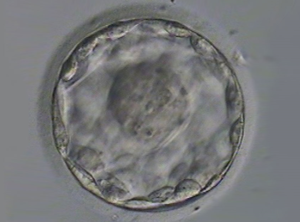
A retrospective study published by JAMA and conducted by researchers at Brigham and Women’s Hospital found that transferring fresh embryos grown from freshly retrieved donor eggs resulted in a higher live birth rate compared to frozen (cryopreserved and thawed) embryos from freshly retrieved donor eggs.
“For women using autologous eggs, the live birth rate is equivalent, if not better, following frozen embryo transfers compared to fresh embryo transfers,” said senior author Janis H. Fox, MD, attending reproductive endocrinologist in the Brigham’s Center for Infertility and Reproductive Surgery. “However, we noticed that when using fresh donor eggs, frozen embryo transfers seemed to be associated with lower live birth rates compared to fresh embryo transfers. Our study confirms this suspicion and provides important insight for assisted reproduction physicians and the women they treat.”
The difference — a 56.6 percent live birth rate for fresh embryos versus 44 percent for frozen embryos — is clinically and statistically significant, according to Dr. Fox and first author Iris Insogna, MD, MBE, a fellow in reproductive endocrinology and infertility.
In addition to the primary outcome of live birth rate, the study’s secondary outcomes were clinical pregnancy rate and miscarriage rate. Clinical pregnancy rates were 66.7 percent following fresh embryo transfer versus 54.2 percent following frozen embryo transfer. Miscarriage rates were essentially the same between both groups: 9.3 percent with fresh embryos versus 9.4 percent with frozen.
Analyzing Embryo Transfer Cycles Among 33,000+ Women
To conduct the study, Drs. Fox and Insogna, along with Brigham colleagues, analyzed data from the Society for Assisted Reproductive Technology (SART). These data capture information from 370 in vitro fertilization (IVF) clinics across the United States and represents over 95 percent of all IVF cycles in the country.
The study focused on SART data from 51,942 embryo transfer cycles among 33,863 women undergoing assisted reproduction using fresh donor eggs. Although much of the SART data is available to the public at www.sart.org, researchers must apply to SART to gain access to the granular data needed to conduct studies such as this one. Dr. Fox called the extensive SART data set “an incredibly valuable resource to answer questions such as ours.”
A Rise in Frozen Embryo Transfers
Among women using freshly retrieved donor eggs, frozen embryo transfers have become increasingly popular. Dr. Insogna noted that this trend is due in part to the fact that fresh embryo transfers in women using fresh donor eggs are logistically complicated, requiring perfect synchronization between preparation of the recipient’s uterus and the egg donor’s follicular stimulation.
In addition, the increased use of frozen embryos is possibly related to the growing utilization of preimplantation genetic testing to ensure the embryo has the correct number of chromosomes (a process that necessitates freezing the embryos while awaiting the results).
“We have a fantastic cryopreservation program here at the Brigham. For women using fresh donor eggs, both fresh and frozen embryos are associated with excellent live birth rates,” Dr. Insogna said. “Our study helps provide evidence-based guidance for women contemplating their assisted reproduction options and gives physicians a valuable counseling tool to help their fresh donor egg recipients make the most informed decisions.”
Dr. Insogna added that while the practice of genetically testing embryos has gained in popularity, a recent randomized controlled trial found that for women under the age of 35, transferring genetically tested embryos showed no benefit. This JAMA study of embryos generated from fresh donor eggs found that live birth rates were higher following the transfer of untested fresh embryos, even when compared with the transfer of tested frozen embryos that were known to contain the normal number of chromosomes.
In addition, some patients might find the complexities involved in synchronizing the recipient’s uterine lining with the egg donor’s stimulation in order to enable a fresh embryo transfer to be burdensome. However, this study suggests patients should be counseled that by electively freezing all of their embryos, they may compromise their chances of a live birth. Given the expense of fresh donor egg cycles (as much as $40,000), this study provides useful data to help inform these nuanced clinical decisions.